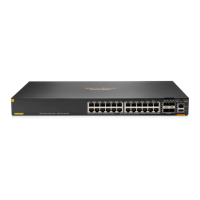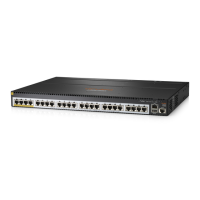145
Manually assigning an IPv6 global unicast address
1. Enter system view.
system-view
2. Enter interface view.
interface interface-type interface-number
3. Assign an IPv6 global unicast address to the interface.
ipv6 address { ipv6-address prefix-length |
ipv6-address/prefix-length }
By default, no IPv6 global unicast address is configured on an interface.
Stateless address autoconfiguration
About stateless address autoconfiguration and temporary address
Stateless address autoconfiguration enables an interface to automatically generate an IPv6 global
unicast address by using the address prefix in the received RA message and the interface ID. On an
IEEE 802 interface (such as an Ethernet interface or a VLAN interface), the interface ID is generated
based on the interface's MAC address and is globally unique. An attacker can exploit this rule to
identify the sending device easily.
To fix the vulnerability, you can configure the temporary address feature. With this feature, an IEEE
802 interface generates the following addresses:
• Public IPv6 address—Includes the address prefix in the RA message and a fixed interface ID
generated based on the MAC address of the interface.
• Temporary IPv6 address—Includes the address prefix in the RA message and a random
interface ID generated through MD5.
You can also configure the interface to preferentially use the temporary IPv6 address as the source
address of sent packets. When the valid lifetime of the temporary IPv6 address expires, the interface
deletes the address and generates a new one. This feature enables the system to send packets with
different source addresses through the same interface. If the temporary IPv6 address cannot be
used because of a DAD conflict, the public IPv6 address is used.
The preferred lifetime and valid lifetime for a temporary IPv6 address are determined as follows:
• The preferred lifetime of a temporary IPv6 address takes the smaller of the following values:
{ The preferred lifetime of the address prefix in the RA message.
{ The preferred lifetime configured for temporary IPv6 addresses minus DESYNC_FACTOR
(a random number in the range of 0 to 600 seconds).
• The valid lifetime of a temporary IPv6 address takes the smaller of the following values:
{ The valid lifetime of the address prefix.
{ The valid lifetime configured for temporary IPv6 addresses.
Restrictions and guidelines
To generate a temporary address, an interface must be enabled with stateless address
autoconfiguration. Temporary IPv6 addresses do not overwrite public IPv6 addresses, so an
interface can have multiple IPv6 addresses with the same address prefix but different interface IDs.
If an interface fails to generate a public IPv6 address because of a prefix conflict or other reasons, it
does not generate any temporary IPv6 address.
Executing the
undo ipv6 address auto command on an interface deletes all IPv6 global unicast
addresses and link-local addresses that are automatically generated on the interface.

